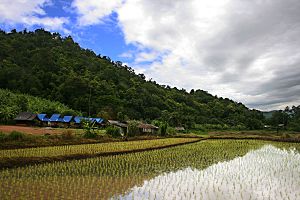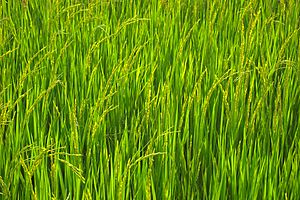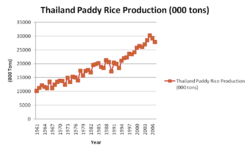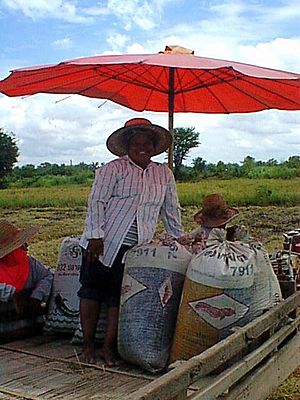Rice production in Thailand facts for kids
Rice production in Thailand is super important for the country's economy and for many people's jobs. In 2017, all the Thai rice sold was worth about 174.5 billion Thai baht. That's a big part of all the farm products! About 16 million people who work in farming in Thailand are rice farmers.
Thailand has a long history of growing rice. It has the fifth-largest area of land used for rice farming in the world. It's also the second-biggest exporter of rice globally. Thailand plans to add even more land for growing rice. They want to add 500,000 hectares to their already huge 9.2 million hectares of rice fields. Half of all the farm land in Thailand is used for rice!
The Thai Ministry of Agriculture thinks that about 27 to 28 million metric tons of rice will be grown in the 2019–2020 season. This number might be a bit lower because of floods and droughts. Jasmine rice, also called khao hom mali, is a very popular and high-quality type of rice grown in Thailand. People in Thailand believe that only certain provinces like Surin, Buriram, and Sisaket can grow the best hom mali rice. Jasmine rice doesn't grow as much as other types, but it sells for more than double the price around the world.
Because of ongoing droughts, experts think that rice production might drop by more than a fifth in 2016. Thailand can usually grow three rice crops a year. But due to water shortages, the government is asking farmers to grow crops that need less water. Or even skip one crop. Rice needs a lot of water. One estimate says it needs about 1,500 cubic meters of water for every rai of land.
Contents
- How Rice Farming Started in Thailand
- Why Rice is So Important
- Environmental Challenges for Rice Farming
- Different Types of Rice
- Pests that Affect Rice
- Government Rules and Rice Farming
- Rice Production and What Thailand Sells to Other Countries
- New Ways of Growing Rice
- Rice Farming Traditions
- Rice Cartel Idea
- Awards and Recognition for Thai Rice
How Rice Farming Started in Thailand
Until the 1960s, most rice farming in Thailand was done by small farmers. They worked on small areas and grew just enough rice. The Chao Phraya River delta was the main area for growing rice. Farming was a huge part of Thailand's economy, and most Thai people worked on farms. This focus on farming happened for two main reasons. First, there was a lot of land available. Second, the government helped farmers get land and protected their rights. They protected farmers from rich landlords.
Because the government helped farmers, city merchants couldn't control the rice industry much. The government cared about protecting farmers, not just about growing a lot of rice. So, Thailand was pretty self-sufficient. Farmers owned their own land, and they often helped each other with farm work. They usually grew just enough rice for their families to live on.
Later, Thailand started to protect its rice farmers less and work more with merchants. The government began to focus on growing more rice and getting more money from the rice industry. They worked with merchants to make this happen, and it worked very well.
King Bhumibol helped a lot with rice policies during his time as king. He greatly increased rice production. Because of this, he received a special award called the Borlaug Medallion in 2007.
Why Rice is So Important
Rice is super important to Thai society. It uses more than half of Thailand's farm land and half of its workers. In 2020, out of eight million farm families in Thailand, four million grew rice. Rice is also one of the main foods for most Thai people. In 2013, each person ate about 114.57 kilograms of rice per year. Rice is also a major product that Thailand sells to other countries.
Even though rice is so important, the industry faces challenges. Experts say the top three problems are:
- More competition in the world market.
- More competition from other jobs, which makes labor costs higher.
- Damage to the environment where rice is grown.
Rice research needs to help solve these problems.
Environmental Challenges for Rice Farming
Climate change is hurting rice harvests and will continue to do so. A study found that rice yields drop when the average daily temperature goes above 29 degrees Celsius. The quality of the rice also gets worse as temperatures rise.
Another study showed that for every 1 degree Celsius increase in global temperature, rice yields could drop by about 3.2%.
Traditional rice farming is the second biggest source of greenhouse gases from agriculture, after livestock. About 4.5% of all agricultural greenhouse gas emissions come from traditional rice farming worldwide. This gas, called methane, comes from organic material rotting underwater in flooded rice fields. Scientists are looking for ways to reduce this methane.
Different Types of Rice
Jasmine rice (Hom mali) started in Thailand and is still the most popular type of fragrant rice. The Rice Department released five new types of rice to celebrate the Coronation of Vajiralongkorn in 2019. Each new type is named "...62" after the Buddhist year 2562. This continues a tradition started by an old king, Chulalongkorn. He started a royal rice competition in 1807. Thailand keeps a collection of 24,000 types of rice seeds, and 20,000 of them are native Thai types.
Pests that Affect Rice
Two common insect pests are Nilaparvata lugens and Sogatella furcifera. Farmers often use insecticides to control them. But they can also be controlled more cheaply by using insecticides and planting flowers that attract helpful insects. These helpful insects eat the pests.
Tungro disease is also a constant problem for rice. A type of wild rice found in Sukhothai Province in 1990 was very good at resisting tungro and other pests. This wild rice is now used in some new rice types to help them resist diseases.
Helpful Insects for Pest Control
Anagrus nilaparvatae and Anagrus optibalis are helpful insects that eat the pests mentioned above. They are attracted to plants that produce nectar. Farmers can plant these nectar-producing plants among their rice. This is a cheap way to get more rice and use less insecticide.
Government Rules and Rice Farming
The government wanted to help cities grow. One way they did this was by taxing the rice industry and using that money in big cities. In 1953, taxes on rice made up 32% of the government's income. The government also set a special low price for rice exports. This increased tax money and kept rice prices low inside Thailand. This meant money was moved from farmers to the government and to people in cities who bought rice. These rules were called the "rice premium." They were used until 1985 when the government finally stopped them. This change meant the rice industry became more focused on making money, rather than helping small farmers.
The Thai government really wanted to grow more rice, and they were mostly successful. The government put money into irrigation systems, roads, and other projects to help rice farming. The World Bank also helped pay for dams, canals, and ditches. These projects were part of the Greater Chao Phraya Project. Policies that helped small farms get machines also protected Thai machine makers from foreign competition. This led to many small machines being made in Thailand. By the late 1990s, nearly two million small tractors and many other farm machines were made locally.
With better water access and more machines, rice farms grew from 35 million to 59 million rai from the 1950s to the 1980s. The total amount of rice grown has tripled! While Thailand's rice production hasn't increased every single year, it has grown a lot since the 1960s.
Starting in 2010, the government changed its mind. It went from encouraging rice farming to discouraging it. They started a program to encourage rice farmers to switch to other crops. The government offered money to farmers who changed their rice fields to grow other crops. At that time, Thailand's sugar factories needed a lot more raw sugarcane. Since sugarcane had a good market and rice prices were falling, many farmers switched. This change has caused some debate. First, rice is a main food, but sugar is not. Second, growing sugarcane often involves using a chemical called paraquat, which can harm the environment.
How Government Policies Affected Farmers
While these changes helped grow more rice overall, many low-income farmers in Thailand ended up worse off. Many farmers couldn't keep their land and became renters. The United Nations estimates that the number of Thai farmers who owned their land dropped from 44% in 2004 to just 15% in 2011. The government demanded taxes, even in bad years, which made things harder for poor farmers. Farmers have gathered a lot of debt, about 338 billion Thai baht. New farming technologies also made it more expensive to start rice farming. This made it harder for farmers to own their land. Many farmers had to borrow money from loan sharks to keep farming. In 2017, farm debt, mostly from rice farmers, added up to 2.8 trillion baht.
Farmers who already had big farms or could afford new chemicals and tractors did very well. But the average small farmer often went from owning land to working for others.
Rice Production and What Thailand Sells to Other Countries
Thailand became a major rice producer because rice farming grew a lot in northeast Thailand. In the past, central Thailand was the main rice-growing area. But northeast Thailand quickly caught up. This happened partly because new roads connected northeast Thailand to ports on the coast. Farming villages also changed. Farmers started working for wages instead of just growing food for themselves. Farmers helping each other with work also almost disappeared.
Farm animals were replaced by tractors, and irrigation technology was updated in most villages. The "green revolution," which brought new farming methods, was just starting. Rice farmers and merchants used new rice types, fertilizers, and other improvements. The International Rice Research Institute (IRRI) shared knowledge, technology, and new rice types with Thai farmers. From the 1950s to the 1970s, rice production per area of land increased by almost 50%.
In 2014, Thailand sold 10.8 million metric tons of milled rice to other countries. This was worth US$5.37 billion, the highest amount ever for Thailand. Rice exports went down in 2015 to 9.8 million metric tons. This made Thailand the world's second-biggest rice exporter, after India. In 2017, Thailand exported a record 11.63 million metric tons of rice. This was up 14.8% from the year before. Sales money went up by 15% to 168 billion baht. About 70% of Thailand's rice exports are regular white rice, and the rest is hom mali. Some special types like riceberry are also exported in small amounts. Exports dropped in 2019 to less than 8 million metric tons. This was due to the strong Thai currency, floods, droughts, and more competition. Thailand expects to export 7.5 million metric tons in 2020.
Ubon Ratchathani Province is the top rice-producing province in Thailand. It earns more than 10 billion baht a year from selling rice.
Some people in Thailand think it's better to add value to rice at home instead of just selling it as a basic product. For example, Thailand has sold about 200,000 metric tons of a type of rice called indica rice to Japan since 1980. This rice is sold for 10–20 baht per kilogram. In Japan, this rice is used to make an alcoholic drink called Awamori. This Japanese drink is then sold back to Thailand for 2,500 baht per liter. That's 170 times the price of the raw rice! In Thailand, small local businesses are not allowed to make their own liquor. A law from 2017 says they must produce at least 30,000 liters per day. This makes it very hard for small craft distilleries to start up.
Competition from Other Countries
In 2020, India was the world's top rice exporter. Vietnam is also catching up fast. Thai farmers are losing the race in how much rice they can grow per area compared to other countries. In Vietnam, farmers can grow 800 to 1,000 kilograms of rice per rai. But in Thailand, farmers only grow about 450 kilograms per rai. It's also estimated that Vietnam's costs to produce rice are 50% lower than in Thailand.
How Droughts Affect Rice
In 2008, a drought in Southeast Asia, caused by El Niño, made Thai rice prices jump to US$1,000 per metric ton. That year, less rice from Thailand, India, and Vietnam caused India to stop exporting rice. This made global prices skyrocket and even caused food riots in some countries.
Starting in late 2014, Thailand's rice industry was hit by another drought that lasted until 2016. At the same time, people around the world were buying less rice. This drought was expected to cost Thailand's economy about 84 billion baht in 2016. Farmers were suffering. Farm production dropped by seven to eight percent in each of the past two years. Farmers' debt was almost as much as their farming income. The government approved 11.2 billion baht in 2015 to help farmers. They encouraged farmers to plant crops that need less water. Rice was the main target for reducing water use because it needs two and a half times more water than wheat or corn. The main dams in central Thailand were at their lowest levels since 1994. The government wanted to cut rice production by 25% in the planting season starting May 2016.
Problems with Land Ownership
Many farmers are in debt to local business people for their land loans. The number of farmers who own their land in Thailand has gone down a lot. It dropped from 44% in 2004 to just 15% in 2011. Problems with land rights have become worse because of political issues over the past 15 years. Often, new governments don't keep the promises about land rights that past governments made to farmers.
Rice Prices and Organic Rice
In 2011, farmers in Thailand could sell a kilogram of rice for 16 baht. In 2016, to earn 16 baht, a farmer had to sell three kilograms because the worldwide price of rice went down. This drop in price led the government to give farmers money to help them, about 38 billion baht.
One good thing about prices is organic rice. While rice mills pay farmers only 7,000 baht per ton for regular rice, organic rice farmers can get up to 45,000 baht per ton! Sales of organic rice went up by 28% in 2016.
Organic Rice Farming
Thanks to a program started over 40 years ago by a local monk, Surin Province produces about 4,200 metric tons of organic jasmine rice each year. A local group, the Rice Fund Surin Organic Agriculture Cooperative Ltd, sells its rice to countries like France, Hong Kong, Singapore, Switzerland, and the United States. Organic rice farmers in Surin get 15 baht per kilogram for their rice, while regular jasmine rice sells for 9 baht per kilo. Since organic farmers don't pay for chemical fertilizers, they can earn about 80,000 baht per crop on an average farm. The success of this organic rice group has helped reduce poverty in Surin compared to its nearby province, Sisaket.
New Ways of Growing Rice
Some farmers in northern Thailand have had success with a method called the System of Rice Intensification (SRI). This method helps grow more rice with less water. A German aid agency, GIZ, is working with the Thai government on a "sustainable rice platform." Their current program, "Thai Rice NAMA," aims to solve problems like traditional flooding of rice fields. Flooding releases a lot of methane gas into the air.
Rice Farming Traditions
Rain-making ceremonies are common for rice farmers in Thailand. One ceremony happens in Bangkok. The lord of the Royal Plowing Ceremony throws rice kernels as he walks around the Grand Palace, with the crown prince watching. Another tradition in central Thailand is a "cat procession." Villagers parade a cat around and throw water at it. They believe a "crying" cat brings a good rice harvest. The Rice Department released five new types of rice to celebrate the Coronation in 2019. These are all named "...62" after the Buddhist year 2562.
Rice Cartel Idea
Thailand has suggested several times creating a "rice cartel" with Vietnam, Myanmar, Laos, and Cambodia. Like the OPEC group that controls oil, this cartel would control rice production and set prices. Thailand sent a plan for such a group to these countries but took it back in 2008. Experts think such a group wouldn't work because the countries might not cooperate. Also, they can't fully control what farmers grow. Thailand is now looking into a more discussion-based international group to talk about rice supplies and harvests.
Noppadon Pattama, who was Thailand's foreign minister, wanted to call this group the "Council on Rice Trade Cooperation." In May 2008, he planned to invite China, India, Pakistan, Cambodia, Myanmar, and Vietnam to join. Pattama also said this new group would not do the same work as the International Rice Research Institute (IRRI). IRRI was started in 1960 to "reduce poverty and hunger, improve the health of rice farmers and consumers, and ensure environmental sustainability of rice farming."
Awards and Recognition for Thai Rice
At the 2017 World Rice Conference in Macau, Thailand's hom mali 105 (jasmine) rice was named the world's best rice. It beat 21 other types of rice. Thailand had entered three types of rice in the competition. Since 2009, Thai jasmine rice has won this award five times. In 2018, Cambodian Malys Angkor jasmine rice won. In 2019, Vietnam's ST24 rice won the top prize. This caused worry among Thai rice producers because ST24 is half the price of Thai hom mali.









